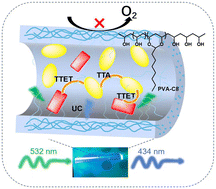Highly stable and air-resistant photonic upconversion organogels with self-healing and temperature responsiveness†
Abstract
Effective triplet–triplet annihilation photon upconversion (TTA-UC) is usually difficult to achieve under aerobic conditions, but is highly desirable for practical applications in which durability is greatly needed to sustain environmental loads and expand the lifespan of the relevant devices. Here, we developed a novel upcoversion organogel with platinum octaethylporphyrin (PtOEP) as sensitizer, 9,10-diphenylanthracene (DPA) as acceptor and n-octanal-modified polyvinyl alcohol (PVA) as structural matrix. The acquired organogel demonstrated self-healing ability and malleability. The exquisite combination of these components affords a variety of features, such as high oxygen resistance, high transparency, strong mechanics, and malleability, benefitting from the dynamic features of the noncovalently crosslinked network and highly compact morphology as well as the enhanced contact probability of the chromophores. The organogel shows effective green-to-blue upconversion, with a quantum yield ΦUC of up to 6.7% in the aerobic environment. The upconversion efficiency of the organogel can maintain over 67% of its original value after long-term sealed storage (>180 days). This research provides a simple and effective strategy for the development of high-efficiency upconversion solid carrier materials.

- This article is part of the themed collections: Journal of Materials Chemistry C HOT Papers and Photofunctional Materials and Transformations


 Please wait while we load your content...
Please wait while we load your content...